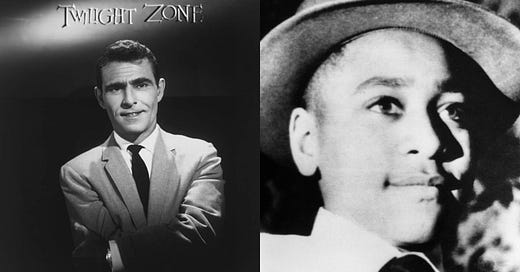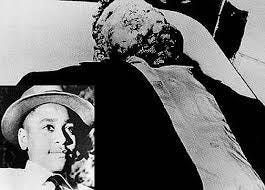How the Emmitt Till Story Inspired “Twilight Zone”
Rod Serling believed art should deal with social justice issues
Issue #100 Fun Friday August 5, 2022 (about 3 minutes reading time)
I’ve been a Twilight Zone fanatic since it was first originally on television (yes, I’m that old...)
I’ve watched every episode a gazillion times.
But I recently learned this fact about the origin of the seminal series.
For our 100th article and our first “Fun Friday” article, here is the story of how a horrific racist incident in American history inspired one of the best shows in U.S. television history.
The murder of Emmitt Till
In 1955, 14-year-old Emmitt Till, who lived in Chicago, was sent to visit relatives in Mississippi. While visiting a corner store, he was accused of “whistling at a white woman,” a 21-year-old cashier at the store. The woman’s husband and his brother kidnapped Emmitt, beat him, shot him, and dropped his body in a nearby river, weighted down by a portable fan. His body wasn’t found until three days later. At the trial in September 1955, the men were found not guilty by an all-white jury that deliberated a total of 67 minutes. A few months later, the two men, knowing they were protected by double jeopardy, admitted during an interview with Look magazine that they had murdered Emmitt Till.
(Carolyn Bryant, the white woman whose accusation led to Emmitt Till’s murder, is now 88 years old and living with her son in Kentucky under palliative care, suffering from cancer. An unserved warrant for her arrest still exists.)
Emmitt’s bereaved mother, Mamie Till, published a photo of Emmitt’s bloated and mutilated body in his open casket in Jet magazine. The incident helped to spur the modern civil rights movement; experienced civil rights activist Rosa Parks started the Montgomery Bus Boycott on December 1, 1955.
Rod Serling’s Fight to Use Television for Social Justice
In 1955, Rod Serling was a 30-year-old up-and-coming teleplay writer for the fairly new medium of television. He believed that the “writer…must see the arts as a vehicle of social criticism and…focus on the issues of his time.”
He wanted to write a teleplay about the racism that led to Emmitt Till’s murder, but his completed draft was so thoroughly censored and watered down by the advertisers and networks who were afraid of Southern white backlash that Serling re-thought his approach to using television as he envisioned it.
Serling finally realized that the only way he could tackle issues such as racism and prejudice on television was to write and produce his own show. He decided that using metaphors and allegories to indirectly address the issues he felt so strongly about would be easier to “sell” to the advertisers and networks.
So Rod Serling was never able to bring the story of Emmitt Till to the television screen; instead, “Twilight Zone” was born. The original TV series lasted for five seasons, from 1959 through 1964.
At the beginning of the run of the “Twilight Zone,” Rod Serling was interviewed by Mike Wallace:
What are your favorite Twilight Zone episodes? Let us know in the comments.
Help us to grow!
We have an iOS app!
WE are because of YOU!
“We Are Speaking” is a reader-supported publication. We publish 7 days a week, and a paid subscription costs just 35¢ a day! To receive new posts and podcast episodes and to support our work, please consider becoming a free or paid subscriber. Thank you!







At the end of the interview, Mike Wallace thanks Rod Serling for "adding his portrait to our gallery."
I wonder if Mr. Serling had that line in his mind when, 11 years later, he offered his "Night Gallery" of "Twilight Zone-ish" stories to television viewers.
The answer is of no importance as I find both of these men to have been tops in their chosen field.